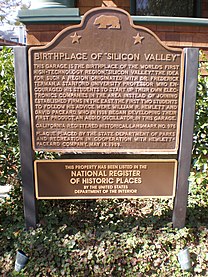Packard's Garage
The garage has since been designated a California Historical Landmark and is listed on the National Register of Historic Places. Though not open for public tours, the property can be viewed from the sidewalk and driveway.
History
The home, originally designated as 367 Addison Avenue, was first occupied in 1905 by John Spencer, his wife Ione, and their two adult daughters. John Spencer became Palo Alto's first mayor in 1909. In 1918, the house was divided into two separate apartments, numbered 367 and 369.
In 1937, David "Dave" Packard, then 25 years old, visited William "Bill" Hewlett in Palo Alto and the pair had their first business meeting. Both men attended Stanford University, where its Dean of Engineering Frederick Terman encouraged his students to establish their own electronics companies in the area instead of leaving California.
In 1938, newly married Dave and Lucile Packard moved into 367 Addison Ave, the first-floor three-room apartment, with Bill Hewlett sleeping in the shed. Mrs. Spencer, now widowed, moved into the second-floor apartment, 369 Addison. Hewlett and Packard began to use the one-car garage, with $538 (equivalent to $11,645 in 2023) in capital.
In 1939, Packard and Hewlett formed their partnership with a coin toss, creating the name Hewlett-Packard.
Hewlett-Packard's first product, built in the garage, was an audio oscillator, the HP200A. One of Hewlett-Packard's first customers was Walt Disney Studios, which purchased eight oscillators to test and certify the sound systems in theaters that were going to run the first major film released in stereophonic sound, Fantasia.
|
Historical designations
- California registered landmark, 1987
- National Register of Historic Places, 2007
References
- ^ "National Register Information System – Hewlett--Packard House and Garage (#07000307)". National Register of Historic Places. National Park Service. November 2, 2013. Retrieved October 22, 2018.
- ^ "Birthplace of Silicon Valley". Office of Historic Preservation, California State Parks. Retrieved October 14, 2012.
- ^ The street lent its name to Hewlett-Packard's employee credit union, known until 2010 as "Addison Avenue Federal Credit Union". The name changed in 2011 to "First Tech Federal Credit Union" after a merger with First Tech Credit Union.
- ^ "HP Feature Stories". www.hp.com. Retrieved April 13, 2018.
- ^ Markoff, John (April 17, 2009). "Searching for Silicon Valley". The New York Times. Archived from the original on February 10, 2014. Retrieved February 26, 2011.
- ^ "HP Garage Timeline". Archived from the original on January 20, 2011. Retrieved December 31, 2009.
- ^ "HP Garage" (PDF). Hewlett-Packard. Archived from the original (PDF) on August 18, 2021.
- ^ HP’s First Product: The 200A
- ^ "A Deal with Disney: HP 200B Oscillator". www.hp.com. Retrieved April 13, 2018.
- ^ Darlin, Damon (December 4, 2005). "Shrine to Hours of Tinkering in a Garage on the Ground Floor of Silicon Valley". The New York Times. Archived from the original on May 29, 2015.
- ^ Poletti, Therese (June 18, 2007). "HP garage named U.S. landmark". The Mercury News. Archived from the original on May 21, 2007. Retrieved October 22, 2018.



